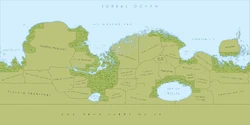| Planetary Commonwealth of Mars |
||||||
|---|---|---|---|---|---|---|
|
||||||
| Motto: "Forged World" | ||||||
| Anthem: "The Star-Spangled Banner" | ||||||
| Capital | Bradbury | |||||
| Largest city | New Richmond | |||||
| English (de facto) | ||||||
| Demonym | American, Martian | |||||
| Government | United States Planetary Commonwealth | |||||
| - | Planetary-Governor | Patrick Kalla | ||||
| - | Lieutenant Governor | Lorn Turner | ||||
| Legislature | Martian Congress | |||||
| - | Upper house | Planetary Senate | ||||
| - | Lower house | Planetary House of Representatives | ||||
| Created per Amendment to the constitution | ||||||
| - | Formation | July 4, 2137 | ||||
| Population | ||||||
| - | 2160 estimate | 3 Billion (2nd) | ||||
| Currency | United States dollar ($) (USD) | |||||
Mars is the fourth planet from the Sun in the Sol System. The planet is named after Mars, the Roman god of war; it is also referred to as the New World, the Red Planet, and the 4th Rock. Home to millions of species, including humans, Mars is the second planet ever to support human civilization after achieving human-rated habitability in 2081, after 50 years of terraforming. Mars was the second Planetary Commonwealth admitted into the Union.
Mars is a relatively dry planet with only half of its surface covered in Water. Mars is a terrestrial planet with an atmosphere conditioned to be as thick as Earth’s, having surface features reminiscent both of the impact craters of the Moon and the volcanoes, valleys, deserts and polar ice caps of Earth. The first humans began exploring Mars in the early 2020s after decades of robotic exploration; the first research colonies sprang up on the surface by the middle of the decade, and in 2030 humans began the decades-long process of terraforming Mars into a habitable world. Since then, humans have significantly altered the atmosphere and other abiotic conditions on the planet, enabling the proliferation of organisms as well as the formation of the ozone layer which, together with Mars’s restored magnetic field, blocks harmful radiation, permitting macroscale life on the surface. The physical properties of the planet Mars, as well as its geological history and orbit, allowed life to persist naturally during a brief period roughly 3 billion years ago, prior to a cataclysmic series of volcanic events and magnetic instability that led to the cooling of the planet and a thinner atmosphere.
Mars’s outer surface has only three tectonic plates, that gradually migrate across the surface over periods of many millions of years. About 53% of the surface is covered with salt-water oceans, the remainder consisting of the single supercontinent (though it is classified as two) and islands; liquid water, necessary for all known life, as it is on Earth. Mars’s interior remained active prior to terraforming, but was extremely weak, with a thick layer of relatively solid mantle.
Both the mineral resources of the planet, as well as the products of the biosphere, contribute resources that are used to support a global human population. Human cultures have developed many views of the planet, including personification as a deity, a new home for humanity, and the first step towards becoming a space-faring civilization.
History[]
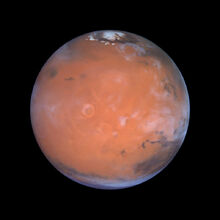
Mars in 1999, prior to the terraforming effort that would begin 31 years later.
Dozens of unmanned spacecraft, including orbiters, landers, and rovers, had been sent to Mars over the course of the early space age by the Soviet Union, the United States, Atlantic Europe, India, China, and Japan to study the planet's surface, climate, and geology.
First Settlers[]
In 2023 the major spacefaring companies came together with NASA to form what would become the Mars Corporation, and committed to the permanent human colonization of Mars. Organized primarily through NASA as a purely scientific mission, the first crewed mission to Mars landed at Terra Meridani in 2026, establishing Meridian Base. Expedition 1, while successful in discovering conclusive proof of long-extinct life in ancient riverbeds, was unable to establish a base that could permanently house colonists without aid from Earth. This was not a terrible setback, as the first privately launched mission by LE. established the first successful base in what is now the city of Bradbury in the Tharsis Territory. NASA, initially hesitant to be tied down by private companies seeking to exploit Mars beyond scientific interest, revised their relationship with the Mars Corporation so that NASA scientists would simply be stationed at MarsCorp bases.
Shortly after the success at Bradbury, SpaceX founded the city of Opportunity at the landing site of the famous rover. Successful early colonies were largely subterranean, usually constructed inside lava tubes much as lunar colonists had done. Successful American settlement on the western hemisphere continued with the Tharsis Colony in 2027 at Heinlein and Elon's Purchase at Sagan in 2028. Early experiments in communal living failed until the introduction of private farm holdings at Bradbury and Heinlein. Most settlers in every colony were technicians, engineers, or terraforming scientist, but other industries developed over the years as smaller research stations and largely unmanned industrial and resource extraction sites were established.
The Mars Corporation, as an entity tied to the US Government, could not legally accept non-US Citizens as colonists for fear of technology theft, and as such was limited to an entirely domestic labor pool, which was already overburdened by the population crisis. These purely American companies then proceeded to divide the planet Mars into administrative possessions that would become the colonies, with each colony or territory being tied directly to one of the Mars Corporation's member organizations. NASA could not legally claim ownership to any territory in accordance with the 1967 Outer Space Treaty, but private companies were still free to administer these regions without ceding them directly to the United States. The largest possessions were claimed by SpaceX and Lunar Energy Ltd. (LE), the two largest contributors to the project at the time outside of NASA.
A problem quickly arose in this rapid settlement as food production in many of the cities could not keep up with the nutritional demands of the colonists, save for those in the Tharsis Territory, where LE, the most established off world corporation prior to Mars, focused its efforts away from an immediate return on its investments to instead develop lasting food supplies. With many smaller problems revealing themselves on an almost daily basis, MarsCorp was partially reorganized for more cooperation between the colonies, with the construction of the New Richmond Space Elevator, and the Mars Transit network between the Tharsis and Argyre colonies. As agriculture developed, major crops included rice, corn, and wheat.
Terraforming[]
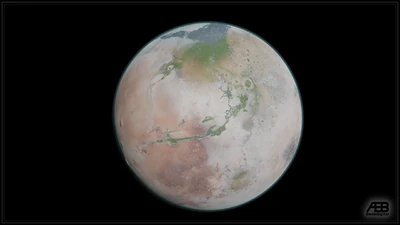
Mars as it appeared from orbit after initial comet bombardment and extremophyte seeding.
Shortly after initial settlement, the colonies began the most ambitious of MarsCorp's projects: The Terraforming Program. From the first touchdown at Bradbury, the colonists began spreading a cocktail of genetically modified organisms (GMOs) across the planet via disposable drones. These organisms, little more than extremophyte bacteria, spread across the planet's surface processing the toxic dust into a usable soil base and extracting greenhouse gasses from the lithosphere. When a given condition of these organisms would be met (O3 levels rising to a certain point, the selenium content of the soil, etc.) a fail-safe in their genome would trigger their demise, depositing more vitamins into the new soil base. The terraforming project was not sanctioned by any government entity, and had begun entirely by the volition of the colonists, who were left largely unsupplied and unmonitored during the White Tide. During this period, the first asteroid and comet redirect missions were undertaken to generate more heat in the atmosphere.
In 2033 NASA was given a mandate to support the effort through the creation of the Green Magnetoshield. The 2 Tesla magnetic field generator, often called a magnetic shade was positioned at Mars-Solar L1 and to this day serves as the planet's main defense against solar winds and radiation. This project was undertaken partly to enable easier near-term colonization, but also to regain control of colonies that were in near-rebellion during the insurrection in the terrestrial US. Technology transfer from terrestrial biotech projects would bring new generations of engineered extremophytes to Mars as well. These organisms would continue to create a suitable topsoil layer through the deposition of humus, produce atmospheric gases.
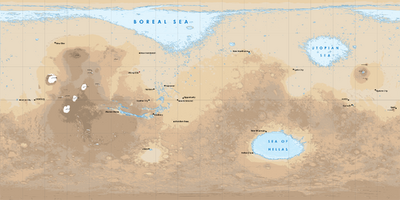
Mars and its colonies in 2037.
From this continuous addition of heat and a thicker atmosphere to hold it all in, Mars rapidly developed oceans over the course of the next two decades. The red planet now had a foundation from which to develop a biosphere, and while it would take decades, Mars was now on its way to habitability.
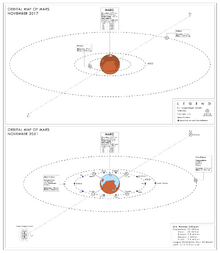
By 2050 Mars's oceans had expanded to cover the northern lowlands of the planet. Riverbeds were dredged, and canals carved to provide water to the interior. Genetically tailored algae, lichens, fungi, and simple mosses and ferns were added to the planet during the 2040s to build the all-important topsoil from the now slightly less toxic dust. By the middle of the 2050s the first trees were being introduced along with the first insects. In addition, the seas were being pumped full of a host of genetically tailored corals and plankton to take advantage of the iron-rich seawater. Surface temperatures at the equator hovered around 25 degrees C during the long summer, increased incrementally with the nitrogen shipments from Titan.
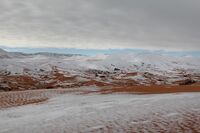
The dunes of southern Noachia by 2050.
The atmosphere was just dense enough at this point to allow settlers to exit the protective domes without full pressure suits. For Mars WWIII wasn't just a distant event that they could not realistically participate in, as it was for the outer colonies. The emotional weight of the war was still felt, as colonists had old friends and family who fought and died to preserve their safety and freedom from the endless conflicts of Earth.
First Martian Revolution[]
The First Martian Revolution, wasn't really a revolution by any definition known to the politicians on Earth, but to Mars it was the closest they'd ever come to such a change. Mars's first wave colonial population was comprised almost entirely of people who would work to see Mars terraformed over the course of a century, reaching habitability in the late 2070s. That kind of commitment requires a level of patience that isn't seen in most humans, and therefore political change comes more easily as acts of adaptation and compromise. In the 2030s the Mars Corporation changed from a confederacy of semi-autonomous corporate purchase, to a commonwealth of territories under corporate rule. In the 40s they changed again, as the corporations that founded Mars began using it as a staging point for the outer planets, its citizens ruled themselves more directly. In the 2050s Mars was officially acknowledged as a US Territory and granted a resident commissioner in the US Congress. In the 2060s the non-human rights movement came to Mars, and new questions of liberty began to be asked.
In the 2070s its citizens began to formally call for full representation in the US Congress. These calls were less for the current citizens, and more for Mars as a whole. When the population cap would be lifted and the billions of new citizens flooded in from Earth, would they be left without representation? As economic activity increased exponentially with the new citizens and the lifting of travel limits, would they be taxed and regulated by a government that did not represent them? For five years these questions went unanswered, and for five years the people of Mars grew restless. Talk of banning all immigration to the United States directly threatened Mars's future, and leave the planet bankrupt. The Mars Corporation, which had been a relatively "hands off" entity in the daily lives of Mars's population began meeting to discuss post-Settlement governance of the planet, and just like the US Government, they were content to leave the Martian people out of the conversation. When MarsCorp Chairman Kanzaki announced the plan to impose planet wide fees on products imported from Earth and travel between the territories, Mars finally spoke up. Protests, boycotts, and strikes broke out planet-wide, and Mars seemed poised for Revolution against MarsCorp, and potentially the United States on Earth.
In 2079, on the eve of the next Presidential election, and as MarsCorp's shareholders were reeling from profit losses and the potential loss on their territorial claims, Galileo Development's President, Adrian Hayer proposed a solution. Galileo Development was an offshoot of Lunar Energy Ltd, and while it did not have a direct stake in MarsCorp, it had been shipping Nitrogen down system from Titan to Mars for four decades. Through LE, Galileo agreed to broker a deal with the colonists and Earth, and purchase 35% of MarsCorp's holdings, in exchange for long term trade between the colonies. MarsCorp would be dissolved after its remaining lands were bought by settlers and after reaching out to popular presidential candidates with promises of Helium-3 deliveries from Neptune, Galileo Development was able to deliver a compromise to Mars. When any immigration bill would be brought before Congress, it would stipulate that its policies would not apply to people wishing to relocate to the colonies. These promises quieted the Martians and in 2081 when the borders were closed the Rosiland Amendment was passed with the broader immigration bill, allowing people to immigrate to the United States on Mars, and granting the Martians the right to divide themselves into Territories, just not states. This was enough to satisfy the Martians, and so the First Martian Revolution drew to a close. The seeds of true revolution, however, were planted, and it would be another generation before they would sprout.
Founding of the ITC[]
With the founding of the Interplanetary Trade Commission in December of 2085, The Martian Economy Grew due to more amounts of raw earth materials being imported to Mars, and a decent amount of Martian Resources being exported from Mars. This also lead to more job opportunities throughout Mars, creating more waves of colonists looking into getting into the labor force.
Second Martian Revolution[]
For decades Mars and the rest of the system's colonies saw their populations grow from a stream of colonists from Earth. By the 2130 census Mars's population had reached 3 Billion citizens, and hundreds of territories. Resident commissioners from these territories constituted a large and deafening voice in the US Congress on Earth, nearly matching the number of every Representative and Senator. Yet their voices were always treated as secondary to the voices of their Terran counterparts. For a time, this arrangement wasn't detrimental to either side. The colonists governed themselves without meddling from Earth, and the nations of Earth were free to act with minimal interruption from the colonies. The bad blood between the colonies and Earth after the Guardiola Incident, had turned from contempt to apathy among the majority of the population. As the situation on Earth deteriorated, however, that feeling began to turn to fear and that fear fed the forces of reaction.
As the struggle between Mexico and the US threatened to explode into a far worse war than any in this century knew, the colonies feared that such a conflict might spread to them; the specter of the Guardiola Incident continued to haunt the minds of the colonists. Mexico had been steadily weaponizing their Orbitals since 2115, and it was no secret that Mexico wanted a piece of the colonies for themselves. This gave fuel to the long dormant Independence movement in the colonies, particularly the Mars Society for Independence and Freedom, which began a more aggressive and often militant push for a formal separation from the United States on Earth. The MSIF argued that only as an independent power could Mars and the rest of the colonies hope to defend themselves, and achieve the rights that the US on Earth had long denied them. They were lead by Maisie Luong, a natural born Martian, and veteran of the Guardiola Incident. Luong rallied her supporters across the planet through propaganda and marches on territory Capitols, often clashing with local police forces. As the Dignidad Party on Earth continued their tirade against the colonies, and Mexico conducted more drills with their Orbitals, the MSIF got louder and more aggressive. It all came to a head when Luong and her supporters stormed the Headquarters of the ITC in Bradbury. Luong hoped to overthrow the ITC, which she and her supporters had come to see as lap dogs of the US government on Earth. Flying red flags and brandishing old weapons and armor from the Guardiola Incident, five thousand MSIF stalwarts clashed with the police, the territorial militia, and finally the Mars Planetary Guard before the mob was put down. The majority of the MSIF was arrested or killed during the fighting and raids on their safe-houses following the Bradbury Riots; Luong herself was killed during one such raid. While the MSIF was destroyed, Luongist supporters from Tharsis to Araby have continued to fly the red flag against the ITC and the US on Earth, a constant reminder of the tensions that threaten to tear the Union apart.
In contrast to the MSIF, and the Independence Movement, the majority of the colonists have renewed calls for full integration into the Union, flooding the Congress of with pro-integration Resident Commissioners. ITC Chairman, Lionel "Leo" Halvidar has been the driving force behind this renewed call to action. A longtime advocate for integration, and one of the most active Chairmen in living memory, Halvidar was seen by most as a moderate between the revolutionaries in the colonies, and the established forces on Earth. The Levin Administration, having lashed itself to Dignidad party leader David Castillo, could do little to answer these calls, being paralyzed with fear over a civil war in the Homeland. Halvidar lobbied the government on Earth with one message, "Bring the colonies into the Union, or you will face TWO rebellions." With the parties busy tearing themselves apart over the 2130 midterms, it doesn't seem likely that this warning will be heeded by the leadership of Earth.
While some in the colonies feared being pulled into a war on Earth, others colonial leaders believed that even if war did not spread to the colonies, Earth would be devastated by a conflict between Mexico and the US, and the colonies would be left to manage untold waves of refugees. With Mars's population reaching its cap, and Venus still not fully Terraformed, this was simply not an option. To prepare for the possibility of devastation on Earth, or outright war, the ITC quietly funded the construction of a series of ruggedized, high speed spacecraft in the Asteroid Belt. They would not be outfitted with weapons, and be crewed only for running relief efforts to the Earth, but the ITC knew they were building a fleet to either end a war on Earth, or at least prevent one on Mars.
Integration and the Third Mexican War[]
The election of Lionel Halvidar and the subsequent secession of the Aztlan rebel states forced the US Congress to begin granting statehood to a number of colonial territories. By 2134, 50 colonial territories were granted statehood, of which included the 35 most populous Martian territories. While this quieted the voices of separatism that hadn't been put down during the Second Martian Revolution, many believed it was a pandering measure to excuse the first taxes on colonial revenue not directly linked to Earthbound trade and transfer control of the colonies from the ITC to the Terran government. The Interplanetary Trade Commission had been formally absorbed into the Federal Government in early 2133 to facilitate President Halvidar's economic reforms, and the Colonial fleet was quietly transferred over to the US Space Force. These actions threatened to create a Third Martian Revolution, however, President Halvidar's popularity among the bulk of the Martian population kept the risk of a widespread uprising at bay.
In 2133, the House of Representatives had passed the 35th Amendment to the US Constitution, introduced almost 11 months ago by Union party leaders, to create a new level of representation between the federal and state level. The Amendment would establish planetary commonwealths, that would govern entire worlds, while the United States as a whole would continue to be governed through the Federal government, which would treat the Commonwealths as it had treated States in the original drafting of the constitution. The amendment was passed by the Senate on September 30, 2135, and would go into effect on the first Election Day following ratification. On New Year's eve, 2136, the Congress brought hundreds of new states into the Union from across the system, including the bulk of those territories applying for statehood on Mars. Integration was celebrated across Mars and resulted in a surge of patriotic expressions that would be essential to colonial action during the Third Mexican War.
Geography, climate, and environment[]
Flora and Fauna[]
Main articles: Flora and Fauna of Mars
Despite an exhaustive search of the planet, no signs of life have been found on Mars, other than some microscopic fossils from the distant past. However, once the planet was terraformed a number of modified Earth organisms were introduced. Here are a few of the most notable.
Mars was the first world to receive a crafted biosphere, almost every living organism on Mars was genetically engineered for the planet by humans. As such, everything living on the planet is designed to not only enable a sustained biosphere but benefit, or at least not harm, its human population. The plant life, for instance, is designed to maintain an atmosphere with a permanent human industrial presence.
Mars has nine life zones which are the lower Noachian (desert); Greater Margartifier (temperate lowlands and some coastal lands), Upper Tharsis and Araby (coastal areas and moist northeastern counties); Hesperia (Mediterranean), Hellas and Argyre basins (rolling grasslands and coastal areas), Mariner Valley, and the Elysian, Olympic, and Antarctic Zones, comprising the planet's highest elevations.
Plant life in the dry climate of the lower Noachian zone contains a diversity of modified cactus, mesquite, and paloverde. Flowering plants include the giant desert poppy and a variety of asters. Ironwood trees thrive along the foothills bordering the planet's higher elevations. The Margartifer lowlands are the most arable land on the planet and chiefly feature agricultural species, as well as Arean Poplar which hugs rivers and lakes to prevent wind erosion.
Demographics[]
Population[]
The U.S. Census Bureau currently estimates the planet's population to be 3,003,102,000. After habitability was achieved, the Martian population exploded with new citizens, climbing from 100 million to over a billion people in just 20 years. The second most populous planet in the system, after Earth, Mars's population had largely leveled off by mid-century. At the turn of the 22nd Century the average woman had 5.014 children, by mid-century this number had decreased to 3.84, still well above the replacement rate of 2.1. As of 2160 the non-terrestrial born population of Mars fell below 50% for the first time in its history.
Religion[]
| Affiliation | % of U.S. population | |
|---|---|---|
| Irreligious | 30.2 | |
| Atheist | 16.5 | |
| Agnostic | 12.6 | |
| Don't know/refused answer | 1.1 | |
| Aerophany Faiths | 23.3 | |
| Crafters | 6.2 | |
| Red Pagans | 5.7 | |
| Avists | 2.7 | |
| Other Martian Faiths | 8.7 | |
| Abrahamic faiths | 21.5 | |
| Christian | 15.8 | |
| Enochian | 5.4 | |
| Catholic (Jesuit) | 4.9 | |
| Eastern Orthodox | 3.8 | |
| Mainline Protestant | 1.7 | |
| Bahá'í | 4.5 | |
| Muslim | 3.8 | |
| Jewish | 0.4 | |
| Dharmic religions | 12.6 | |
| Hindu | 6.9 | |
| Buddhist | 5.5 | |
| Sikh | 0.2 | |
| Other Earth-based religions | 12.4 | |
| Chinese folk-religion | 7.2 | |
| Shinto | 3.7 | |
| Taoist | 1.5 | |
| Other Terran faiths | 0.8 | |
| Total | 100 | |
The largest religious denominations by number of adherents as a percentage of the Martian population in 2160 were Atheists with 16.5 percent; Non-religious Agnostics with 12.6 percent; and adherents of the Chinese folk-religion with 7.2 percent, however the collective religions of the Aerophany make up 23.3% of the population, and combined Abrahamic religions make up an additional 21.5%
The first colonists to come to Mars were mostly secular scientists, engineers, and technicians hired by the Mars Corporation or NASA to aid in exploration and terraforming of the planet. During the early settlement of Mars a schism grew between the more secular colonists and those who began claiming that Mars provided an epiphany for mankind's place in the universe. These early religious thinkers were characterized by strong support for terraforming, ceremonies that involved use of the resources of Mars (such as consuming Martian regolith, or communal bathing in unprocessed glacial melt-water), and a general obsession with spreading biological life. Originally the Aerophany was united as a single, relatively unorganized faith, making up roughly half of the Martian population before the second wave of colonization began in 2081. As Chinese and Indian colonists arrived, many of them joined the Aerophany and began to define it with many of the customs and beliefs they knew from Earth, resulting in a schism that divided the religion into hundreds of sects (this was unique to human history as it was a religious schism that saw virtually no violence). Many adherents to terran religions have incorporated many of the traditions of the Aerophany faiths into their lives, most universally being the disposal of corpses, which on Mars involves placing a seed and biomembrane into the abdomen of the deceased, thus allowing the body to quickly be processed into soil and let a tree sprout from the corpse.
Government and politics[]
When Meridian Base was first established, the residents attempted to create a direct democracy to handle administration and local disputes. Bradbury by comparison embraced an automated administrative system, with a clearly defined leader. These two camps formed the basis for the political culture of Mars between hyperdemocracy and automated government. Early in the planet's political history, Automated government won out after the direct democratic government of Meridian base led to endless infighting and inefficiencies between the colonists, infighting that was only resolved after Bradbury extended their custodial programs to any colony that would take them. In the 2070s, there was a resurgence from the hyper-democratic forces as the Mars Corporation faced continuous uprisings in the First Martian Revolution.
Government[]
The planetary capital is Bradbury. Mars is organized into three branches of government – the executive branch consisting of the Planetary Governor and the other independently elected constitutional officers; the legislative branch consisting of the Planetary House and Senate; and the judicial branch consisting of the Martian Supreme Court and lower courts. The commonwealth also allows ballot propositions: direct participation of the electorate by initiative, referendum, recall, and ratification.
Executive branch[]
The Martian executive branch consists of the Planetary Governor of Mars and seven other constitutional officers appointed by the governor and confirmed by the legislature: Lieutenant Governor, Attorney General, Secretary of State, Planetary Defense, Planetary Treasurer, Health and Social Services, and Education. They serve four-year terms and may be re-elected only once.
Legislative branch[]
The Mars Planetary Legislature consists of a 1,004-member Senate and 2,500-member House. Senators serve four-year terms and House members two. Members of the House are subject to term limits of three terms, and members of the Senate are subject to term limits of two terms.
Judicial branch[]
The Martian legal system is explicitly based upon American common law but carries a few features developed during the colonial period, such as resource nationalization. Capital punishment is a legal form of punishment, but the planet has a smaller "Death Row" population than Earth.
Political Divisions[]
Main article: List of states and territories of the United States
The Mars Commonwealth is a commonwealth of a few hundred states, several territories and a number of orbital and colony ship possessions. The states and territories are the principal administrative districts in the commonwealth. These are divided into subdivisions of counties and independent cities. The states choose the Planetary Governor of the Mars. Planetary Congressional Districts are reapportioned among the states following each decennial Census of Population. The single member districts of each state are drawn according to algorithmic appropriation of representation based on population.
City and town governments[]
Incorporated cities and towns on Mars are either charter or general-law municipalities. General-law municipalities owe their existence to state law and are consequently governed by it; charter municipalities are governed by their own city or town charters. Most cities have a custodian AI form of government, where the elected city council or general populace provide guidance and feedback to a custodian AI that handles the actual day-to-day administration of the city. The largest cities and capital cities of Mars operate as consolidated city-counties , where both the city and county governments have been merged into one unified jurisdiction.
Culture[]
Mars shares much with the greater American over culture, but it was the first world to demonstrate how the realities of a new world can directly influence culture. Most Martians don't observer the Gregorian calendar, the longer year necessitates the 24 month long Darian calendar; thus few holidays that are common to Earth are celebrated on Mars; only American federal holidays are observed, such as Independence Day, Thanksgiving, Memorial Day, Labor day, etc. But of those holidays only Independence day is celebrated with any grandiose ritual equivalent to that of Earth. Mars observes many holidays of its own that aren't celebrated on Earth; Landing day, commemorating the first human mission to the surface; Yuletide, celebrating the winter solstice; Founders day, commemorating the first asteroid that official began the terraforming process. And countless religious holidays observed by the dozens of faiths on Mars.
Food[]
Mainstream Martian cuisine is similar to their Terran counterparts. Wheat is the primary cereal grain with about three-quarters of grain products made of wheat flour. As Mars is a terraformed world, many of its indigenous dishes are similar in style to those on Earth but differ due to genetic engineering. Traditional dishes such as apple pie, hot dogs, pizza, hamburgers, and teriyaki are modified using local equivalents to Earth's ingredients. Martians drink coffee at the same rate as tea; while milk and dragonjuice are ubiquious breakfast drinks.
Moons[]
Mars has two moon Phobos and Deimos. A third, Eris, is being moved down system from the Kuiper Belt via one of the largest gravity manipulating projects ever undertaken. The goal is to slowly rebuild a natural Martian magnetic field over the coming centuries, working in tandem with a series of high energy microwave generators on the surface.



